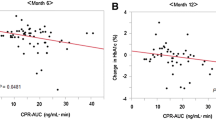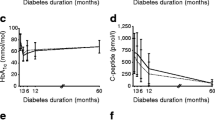Abstract
This study evaluates the effects of glucagon 30 μg/kg (maximal 1 mg) on β-cell function in children by C-peptide determined before and 6 min after intravenous administration. From 1990 to 2005, 118 Taiwanese children with newly diagnosed diabetes mellitus (98 children with type 1 and 20 children with type 2) and 29 normal Taiwanese children were enrolled in this study. Fasting and 6-min post-glucagon C-peptide levels were analyzed. In the pre-pubertal group, the median fasting serum C-peptide levels were 0.2 and 0.8 nmol/l in type 1 diabetes and normal children, respectively. These levels rose to 0.3 and 1.9 nmol/l after glucagon stimulation. In the pubertal group, the median fasting serum C-peptide levels were 0.3, 1.0 and 0.9 nmol/l in type 1 diabetes, type 2 diabetes and normal children, respectively. They rose to 0.4, 2.5 and 2.7 nmol/l after glucagon stimulation. Both fasting and post-glucagon C-peptide levels in type 1 diabetes patients were significantly lower than those of normal children and children with type 2 diabetes. The optimal cut-off values to distinguish type 1 diabetes patients from those with type 2 as determined by the receiving operating characteristic curve were 0.7 and 1.1 nmol/l, respectively. The sensitivities of both C-peptide values were 93%. The post-glucagon C-peptide level was more powerful in distinguishing type 1 diabetes from type 2 diabetes with higher specificity (95% vs. 85%). The 6-min glucagon test is valuable in assessing β-cell function in children and can help pediatricians in the differential diagnoses of diabetes mellitus in children.


Similar content being viewed by others
Abbreviations
- GAD65:
-
65-ka glutamic acid decarboxylase
- IA-2:
-
tyrosine phosphatase
- IAA:
-
insulin auto-antibodies
- BMI:
-
body mass index
- ROC:
-
Receiving Operating Characteristic
- AUC:
-
areas under the ROC curves
References
Alford FP, Henriksen JE, Rantzau C, Vaag A, Hew LF, Ward GM, Beck-Nielsen H (1998) Impact of family history of diabetes on the assessment of β-cell function. Metabolism 47:522–528
American Diabetes Association (2000) Type 2 diabetes in children and adolescents. Pediatrics 105:671–680
Arnqvist HJ, Littorin B, Nystrom L, Schersten B, Ostman J, Blohme G, Lithner F, Wibell L (1993) Difficulties in classifying diabetes at presentation in young adults. Diabetic Med 10:606–613
Ashcroft FM, Ashcroft SJH (1980) Glucoreceptor mechanisms and the control of insulin release and biosynthesis. Diabetologia 18:5–15
Ashcroft FM, Rorsman P (1989) Electrophysiology of the pancreatic beta-cell. Prog Biophys Mol Biol 54:87–143
Berger B, Stenstrom G, Sundkvist G (2000) Random C-peptide in the classification of diabetes. Scand J Clin Lab Invest 60:687–694
Castillo MJ, Scheen AJ, Lefebvre PJ (1995) Modified glucagon test allowing simultaneous estimation of insulin secretion and insulin sensitivity: application to obesity, insulin-dependent diabetes mellitus, and noninsulin-dependent diabetes mellitus. J Clin Endocrinol Metab 80:393–399
Elder DA, Prigeon RL, Wadwa RP, Dolan LM, D’Alessio DA (2006) β-cell function, insulin sensitivity, and glucose tolerance in obese diabetic and nondiabetic adolescents and young adults. J Clin Endocrinol Metab 91:185–191
Faber OK, Binder C (1977) C-peptide response to glucagon. A test for the residual β-cell function in diabetes mellitus. Diabetes 26:605–610
Hanley JA, McNeil BJ (1982) The meaning and use of the area under a receiver operating characteristic (ROC) curve. Radiology 143:29–36
Hother-Nielson O, Faber O, Sorensen NS, Beck-Nielsen H (1988) Classification of newly diagnosed diabetic patients as insulin-requiring or non-insulin-requiring based on clinical and biochemical variables. Diabetes Care 11:531–537
Kolendorf K, Thorsteinsson B, Billesbolle P, Poulsen S (1982) Correlation between the routine 6-min. C-peptide value and the AUC after I.V. glucagon injection in NIDDM patients. Horm metabol Res 14:675–676
Koskinen P, Viikari J, Irjala K, Kaihola HL, Seppala P (1985) C-peptide determination in the choice of treatment in diabetes mellitus. Scand J Clin Lab Invest 45:589–597
Madsbad S, Krarup T, McNair P, Christiansen C, Faber OK, Transbol I, Binder C (1981) Practical clinical value of the C-peptide response to glucagon stimulation in the choice of treatment in diabetes mellitus. Acta Med Scand 210:153–156
Maldonado M, Hampe CS, Gaur LK, D’Amico S, Iyer D, Hammerle LP, Bolgiano D, Rodriguez L, Rajan A, Lernmark A, Balasubramanyam A (2003) Ketosis-prone diabetes: dissection of a heterogeneous syndrome using an immunogenetic and β-cell function classification, prospective analysis, and clinical outcomes. J Clin Endocrinol Metab 88:5090–5098
McCulloch DK, Palmer JP (1991) The appropriate use of B-cell function testing in the preclinical period of type 1 diabetes. Diabetic Med 8:800–804
Petersen KF, Befroy D, Dufour S, Dziura J, Ariyan C, Rothman DL, DiPietro L, Cline GW, Shulman GI (2003) Mitochondrial dysfunction in the elderly : possible role in insulin resistance. Science 300:1140–1142
Poulsen S, Billesbolle P, Kolendorf K, Thorsteinsson B (1985) The C-peptide response to glucagon injection in IDDM and NIDDM patients. Horm Metabol Res 17:39–40
Salmos E, Marri G, Marks V (1965) Promotion of insulin secretion by glucagon. Lancet 2:415–416
Sakura H, Ashcroft SJH, Terauchi Y, Kadowaki T, Ashcroft FM (1998) Glucose modulation of ATP-sensitive K-currents in wild-type, homozygous and heterozygous glucokinase knock-out mice. Diabetologia 41:654–659
Taha D, Umpaichitra V, Banerji MA, Castells S (2006) Type 2 diabetes mellitus in African-American adolescents: impaired beta-cell function in the face of severe insulin resistance. J Pediatr Endocrinol Metab 19:135–142
The Expert Committee on the diagnosis and classification of diabetes mellitus (1997) Report of the Expert Committee on the diagnosis and classification of diabetes mellitus. Diabetes Care 20:1183–1197
Wei JN, Sung FC, Lin CC, Lin RS, Chiang CC, Chuang LM (2003) National surveillance for type 2 diabetes mellitus in Taiwanese children. JAMA 290:1345–1350
Welborn TA, Webb PG, Bonser AM (1981) Basal C-peptide in the discrimination of type I from Type II Diabetes. Diabetes Care 4:616–619
Author information
Authors and Affiliations
Corresponding author
Rights and permissions
About this article
Cite this article
Tung, YC., Lee, JS., Tsai, WY. et al. Evaluation of β-cell function in diabetic Taiwanese children using a 6-min glucagon test. Eur J Pediatr 167, 801–805 (2008). https://doi.org/10.1007/s00431-007-0594-9
Received:
Accepted:
Published:
Issue Date:
DOI: https://doi.org/10.1007/s00431-007-0594-9




